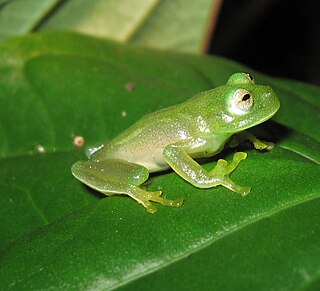
The glass frogs are frogs of the amphibian family Centrolenidae. While the general background coloration of most glass frogs is primarily lime green, the abdominal skin of some members of this family is transparent and translucent. The internal viscera, including the heart, liver, and gastrointestinal tract, are visible through the skin, hence the common name is given as glass frog. Glass frogs are arboreal, meaning they mainly live in trees, and only come out for mating season.

Cochranella is a genus of glass frogs, family Centrolenidae. They are found in Central America from Honduras southward to the Amazonian and Andean cloud forests of Colombia, Ecuador, Peru, and Bolivia.

Hyalinobatrachium is a genus of glass frogs, family Centrolenidae. They are widely distributed in the Americas, from tropical Mexico to southeastern Brazil and Argentina.
"Centrolene" medemi' is a species of frog in the family Centrolenidae. It occurs in the Cordillera Oriental in the Tolima, Caquetá, and Putumayo Departments in Colombia and adjacent Napo in Ecuador. The generic placement of this species within the subfamily Centroleninae is uncertain. The specific name medemi honors Fred Medem, collector of the holotype. Common name Medem giant glass frog has been coined for it.
Centrolene notosticta is a species of frog in the family Centrolenidae. It is found on the Cordillera Oriental in Colombia and on its extension to north, Serranía del Perijá, in the Zulia state in Venezuela.
Nymphargus chancas is a species of frog in the family Centrolenidae. Until recently it was only known from its type locality in the Lamas Province in Peru; however, it is now known to occur more widely in the northern San Martín Region of Peru, extending into the Cordillera del Cóndor in Zamora-Chinchipe Province, Ecuador.
"Cochranella" duidaeana, commonly known as the Duida Cochran frog, is a species of frog in the family Centrolenidae. It is endemic to Cerro Duida, Venezuela. The generic placement of this species within the subfamily Centroleninae is uncertain.

Vitreorana ritae is a species of frog in the glassfrog family (Centrolenidae). It is found in Amazonian Brazil, Colombia, Ecuador, and Peru, and in southern Guyana, eastern Surinam, and French Guiana. Its natural habitats are tropical moist lowland forests and rivers. It is threatened by habitat loss.
"Cochranella" riveroi is a species of frog in the family Centrolenidae. It is endemic to Cerro Aracamuni, Venezuela. The generic placement of this species within the subfamily Centroleninae is uncertain.
"Cochranella" xanthocheridia is a species of frog in the family Centrolenidae. It has an uncertain generic placement within subfamily Centroleninae; molecular data are not available and morphological and behavioural characters do not unambiguously place it in any specific genus.

Centroleninae is one of two subfamilies of the family Centrolenidae. It has nine genera distributed in Central America from Honduras south and east to northern and central South America. As of mid 2015, it contains 117 species.

Vitreorana is a genus of glass frogs that are native to South America, from the Atlantic Forest of Brazil and Argentina to the Amazon rainforest of Colombia and Ecuador and to the Venezuelan Coastal Range and the Guianas.

Hyalinobatrachinae is a subfamily of glass frogs that was established in 2009. They are found in the Americas from Mexico south to southeastern Brazil and Argentina.
Celsiella is a small genus of glass frogs endemic to Venezuela. It was established in 2009 and named in honour of Josefa Celsa Señaris, nicknamed "Celsi", a Venezuelan herpetologist who had worked with glass frogs.

Josefa Celsa Señaris is a Venezuelan herpetologist. She has published information about frogs and she has identified new genera and species. Señaris is the director of the La Salle Foundation's Natural History Museum in Caracas.

Chimerella is a small genus of glass frogs, family Centrolenidae. They are found on the Amazonian slopes of the Andes in Ecuador and Peru, possibly extending into Colombia.

Espadarana is a genus of glass frogs. They are found in Central America and northern South America.

Sachatamia is a small genus of glass frogs. They are found in Central America and northern South America at altitudes below 1,500 m (4,900 ft) above sea level.

Rulyrana is a small genus of glass frogs. They are found in South America, on the Amazonian slopes of the Andes in Ecuador, Peru, and possibly Bolivia, as well as on the eastern slopes of the Cordillera Central and the western slopes of the Cordillera Oriental in Colombia.

Ikakogi is a genus of frogs in the family Centrolenidae. It has been tentatively placed in the subfamily Centroleninae, although more recent analyses suggest that it is the sister group of the clade Centroleninae+Hyalinobatrachiinae.












